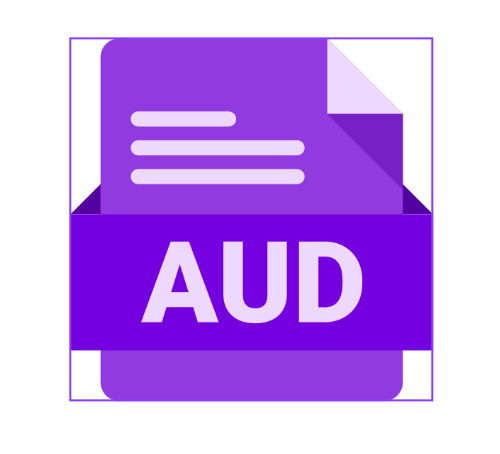.AUD File Extension

Westwood Studios Audio
| Developer | Westwood Studios |
| Popularity | |
| Category | Game Files |
| Format | .AUD |
| Cross Platform | Update Soon |
What is an AUD file?
Files with the .AUD extension are audio files that contain digital audio data. These files are used to store various types of audio content, including music, voice recordings, sound effects, and more.
.AUD files are versatile and can be found in a wide range of applications and contexts, making them an important part of the digital audio landscape.
More Information.
The history of .AUD files is closely tied to the evolution of digital audio technology. Initially, they were created to store audio recordings and playback information on early computer systems.
As audio technology advanced, .AUD files became more versatile and capable of storing high-quality audio data. They have been used in multimedia applications, games, audio editing software, and more.
Origin Of This File.
The .AUD file extension is not associated with a specific software or company. Instead, it is a generic file extension used for audio files.
Various software applications and platforms use this extension to save and play audio data. The origin of individual .AUD files can vary depending on their creation and use.
File Structure Technical Specification.
The structure and technical specifications of .AUD files can vary depending on the software or platform that generates them. The .AUD files contain digital audio data in formats such as WAV, MP3, AAC, or others.
They may also include metadata like track information, artist names, and album details. The technical specifications of .AUD files are determined by the codec and audio format used.
How to Convert the File?
Windows:
- Download Conversion Software: Install a reliable audio conversion software like Audacity or Any Audio Converter.
- Launch the Software: Open the installed software.
- Import the .AUD File: Use the “Open” or “Import” feature to load the .AUD file.
- Choose Output Format: Select the desired output format (e.g., MP3, WAV).
- Convert: Click the “Convert” or “Start” button to initiate the conversion process.
- Save the Converted File: Once converted, save the file in the desired location.
Linux:
- Install Conversion Tool: Use a command like
sudo apt-get install ffmpegto install the “ffmpeg” tool (if not already installed). - Open Terminal: Launch a terminal window.
- Navigate to the .AUD File: Use the “cd” command to navigate to the folder containing the .AUD file.
- Convert Using ffmpeg: Run a command like
ffmpeg -i input.aud -c:a mp3 output.mp3to convert the file to MP3. Adjust parameters as needed. - Retrieve the Converted File: Locate the converted file in the same folder or as specified in the command.
Mac:
- Use Built-In Tools: macOS typically supports various audio formats. You can often convert .AUD files using the built-in “QuickTime Player.”
- Open QuickTime Player: Launch QuickTime Player.
- Import the .AUD File: Go to “File” > “Open File” and select the .AUD file.
- Export as Desired Format: After opening the file, choose “File” > “Export” and select the desired format (e.g., MP3, WAV).
- Save the Converted File: Specify a location and save the converted file.
Android:
- Install a Conversion App: Download and install a reputable audio conversion app from the Google Play Store, like “Media Converter” or “Audio Converter.”
- Open the App: Launch the conversion app.
- Import the .AUD File: Use the app to select and import the .AUD file.
- Choose Output Format: Select the desired output format (e.g., MP3, WAV).
- Convert: Initiate the conversion process within the app.
- Save the Converted File: Once converted, save the file to your preferred location.
iOS:
- Use a Conversion App: Download and install an audio conversion app from the App Store, such as “AudioShare” or “Anytune.”
- Open the App: Launch the conversion app.
- Import the .AUD File: Use the app to import the .AUD file.
- Select Output Format: Choose the desired output format (e.g., MP3, WAV).
- Start Conversion: Initiate the conversion process within the app.
- Save the Converted File: Once the conversion is complete, save the file to your preferred location.
Advantages And Disadvantages.
Advantages:
- Versatile Usage: .AUD files can store various audio content, making them suitable for a wide range of applications.
- High-Quality Audio: Depending on the format used, .AUD files can retain high-quality audio, making them ideal for music and professional audio recordings.
- Compatibility: .AUD files are supported by many audio software and devices, ensuring compatibility across different platforms.
Disadvantages:
- Lack of Standardization: There is no universal standard for .AUD files, leading to compatibility issues between different software and systems.
- File Size: High-quality .AUD files can be large, consuming significant storage space.
- Limited Metadata: Some .AUD files may not support extensive metadata, making it challenging to organize and manage audio collections.
How to Open AUD?
Open In Windows
- Double-click the .AUD file, and it should open in the default audio player.
- Alternatively, right-click the file, select “Open with,” and choose your preferred audio player.
Open In Linux
- Linux supports a variety of audio players. Use your preferred audio player to open .AUD files by navigating to the file and double-clicking it.
- You can also use command-line tools like “ffmpeg” to play .AUD files if necessary.
Open In MAC
- On macOS, double-clicking the .AUD file should open it in the default audio player, such as iTunes or QuickTime.
- If you prefer a different player, right-click the file, select “Open with,” and choose your desired application.
Open In Android
- Android devices have built-in audio players that can handle .AUD files. Simply locate the file and tap to open it.
- You can use third-party audio player apps from the Google Play Store for more features and options.
Open In IOS
- iOS devices like iPhones and iPads natively support various audio formats, including .AUD. Tap on the file in your file manager or email app to open it.
- You can also import .AUD files into apps like Apple Music for playback and organization.
Open in Others
- Find an Audio Player: Use the default player or install one.
- Double-Click: Try double-clicking the .AUD file.
- Right-Click: If that doesn’t work, right-click and choose “Open with.”
- Install Codecs: Install necessary audio codecs.
- Command-Line Tools: Use “ffmpeg” for conversions if needed.













